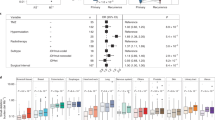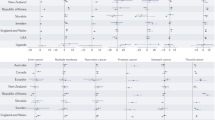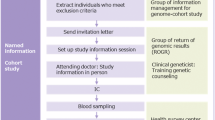Abstract
We previously showed that levels of chromosome damage induced by ionizing radiation were, on average, higher in G2and G0lymphocytes of breast cancer patients than of normal healthy controls, but that there was no correlation between the results in the two assays. We proposed that enhanced sensitivity to G2or G0irradiation was a marker of low-penetrance predisposition to breast cancer, and have recently demonstrated heritability of sensitivity in families of breast cancer cases. We have now applied these assays to patients with head and neck cancers, for whom there is epidemiological evidence of inherited predisposition in addition to environmental causes. The mean frequency of radiation-induced G2aberrations was higher in the 42 patients than in 27 normal controls, but not significantly so. However, cases less than 45 years old were significantly more sensitive than normals of the same age range (P = 0.046), whereas there was no difference between patients and normals of less than 45 years. Also, there was an inverse correlation between G2sensitivity and age for patients but not for normals. Radiation-induced micronuclei in G0cells were more frequent in 49 patients than in 31 normals (P = 0.056) but, as with the G2assay, the greatest difference was seen between early-onset patients and young normals. Again there was an inverse correlation with age for patients but not for normals. Six patients with enhanced toxicity to radiotherapy were G2tested and four other such patients were G0tested; levels of chromosome damage were not significantly greater than in patients with normal reactions. Both assays were used on 64 individuals (39 patients, 25 normals) and there was no significant correlation between the results. We suggest that a proportion of early-onset head and neck cancer patients are genetically predisposed and that each of the two assays detects a different subset of these cases. © 2001 Cancer Research Campaign
Similar content being viewed by others
Article PDF
Change history
16 November 2011
This paper was modified 12 months after initial publication to switch to Creative Commons licence terms, as noted at publication
References
Barber JPB, Burrill W, Spreadborough AR, Levine E, Warren C, Kiltie AE, Roberts SA and Scott D (2000) Relationship between in vitro chromosomal radiosensitivity of peripheral blood lymphocytes and the expression of normal tissue damage following radiotherapy for breast cancer. Radiother Oncol 55: 179–186
Burnet NG, Johansen J, Turesson I, Nyman J and Peacock JH (1998) Describing patients’ normal tissue reactions: concerning the possibility of individualising radiotherapy dose prescriptions based on potential predictive assays of normal tissue radiosensitivity. Int J Cancer 79: 606–613
Burrill W, Barber JBP, Roberts SA, Bulman B and Scott D (2000) Heritability of chromosomal radiosensitivity in breast cancer patients: a pilot study with the lymphocyte micronucleus assay. Int J Radiat Biol 76: 1617–1619
Cannon-Albright LA, Skolnick MH, Bishop T, Lee RG and Burt RW (1988) Common inheritance of susceptibility to colonic adenomatous polyps and associated colorectal cancers. New Engl J Med 319: 533–537
Cloos J, Spitz MR, Schantz SP, Hsu TC, Zhang Z-F, Tobi H, Braakhuis BJM and Snow GB (1996) Genetic susceptibility to head and neck squamous cell carcinoma. J Natl Cancer Inst 88: 530–535
Cloos J, Nieuwenhuis EJC, Boomsma DI, Kuik DJ, van der Sterre MLT, Arwert F, Snow GB and Braakhuis BJM (1999) Inherited susceptibility to bleomycin-induced chromatid breaks in cultured peripheral blood lymphocytes. J Natl Cancer Inst 91: 1125–1130
Copper MP, Jovanovic A, Nauta JP, Braakhuis BJM, de Vries N, van der Waal I and Snow GB (1995). Arch Otolaryngol Head Neck Surg 121: 157–160
Fenech M and Morley AA (1985) Measurement of micronuclei in lymphocytes. Mutation Res 147: 29–36
Foulkes WD, Brunet J-S, Kowalski LP, Narod SA and Franco E (1995) Family history of cancer is a risk factor for squamous cell carcinoma of the head and neck in Brazil: a case-control study. Int J Cancer 63: 769–773
Hsu TC, Johnston DA, Cherry LM, Ramkissoon D, Schantz SP, Jessup JM, Winn RJ, Shirley L and Furlong C (1989) Sensitivity to genotoxic effects of bleomycin in humans: possible relationship to environmental carcinogenesis. Int J Cancer 43: 403–409
Lichtenstein P, Holm NV, Verkasalo PK, Iliado A, Kaprio J, Koskenvuo M, Pukkala E, Skytthe A and Hemminki K (2000) Environmental and heritable factors in the causation of cancer. Analyses of cohorts of twins from Sweden, Denmark and Finland. New Engl J Med 343: 78–85
Morita M, Kuwano H, Ohno S, Sugimachi K, Seo Y, Tomoda H, Furusawa M and Nakashima T (1994) Multiple occurence of carcinoma in the upper aerodigestive tract associated with esophageal cancer: reference to smoking, drinking and family history. Int J Cancer 58: 207–210
Parshad R, Price FM, Bohr VA, Cowans KH, Zujewski JA and Sanford KK (1996) Deficient DNA repair capacity, a predisposing factor in breast cancer. Br J Cancer 74: 1–5
Patel RK, Trevedi AH, Arora DC, Bhatavdekar JM and Patel DD (1997) DNA repair proficiency in breast cancer patients and their first-degree relatives. Int J Cancer 73: 20–24
Peto J and Mack TM (2000) High constant incidence in twins and other relatives of women with breast cancer. Nature Genet 26: 411–414
Rached E, Schindler R, Beer KT, Vetterli D and Greiner (1998) No predictive value of the micronucleus assay for patients with severe acute reaction of normal tissue after radiotherapy. Eur J Cancer 34: 378–383
Roberts SA, Spreadborough AR, Bulman B, Barber JBP, Evans DGR and Scott D (1999) Heritability of cellular radiosensitivity: a marker of low penetrance predisposition genes in breast cancer?. Am J Human Genet 65: 784–794
Scott D, Spreadborough A, Levine E and Roberts SA (1994) Genetic predisposition to breast cancer. Lancet 344: 1444
Scott D, Barber JB, Levine EL, Burrill W and Roberts SA (1998) Radiation-induced micronucleus induction in lymphocytes identifies a high frequency of radiosensitive cases among breast cancer cases: a test for predisposition?. Br J Cancer 77: 614–620
Scott D, Barber JBP, Spreadborough AR, Burrill W and Roberts SA (1999) Increased chromosomal radiosensitivity in breast cancer patients: a comparison of two assays. Int J Radiat Biol 75: 1–10
Scott D, Roberts SA, Spreadborough, Bulman B, Barber JBP and Evans DGR (2000) Chromosomal radiosensitivity and cancer predisposition. Radiation Research, Vol. 2, Congress Proceedings, Moriarty M, Mothershill C, Seymour C, Edington M, Ward JF, Fry RJM (eds) (11th International Congress of Radiation Research), 470–471, Allen Press: Lawrence
Sellers TA (1996) Familial predisposition to lung cancer. Genetic Predisposition to Cancer, Eeles RA, Ponder BAJ, Easton DF, Horwich A (eds). 344–353, Chapman & Hall: London
Son YH and Kapp SD (1985) Oral cavity and oropharyngeal cancer in a younger population. Cancer 55: 441–444
Teare MD, Wallace SA, Haris M, Howell A and Birch JM (1994) Cancer experience in the relatives of an unselected series of breast cancer patients. Br J Cancer 10: 102–111
Terzoudi GI, Jung T, Hain J, Vrouvas J, Margaritis K, Donta-Bakoyiannis C, Makropoulos V, Angelakis PH and Pantelias GE (2000) Increased chromosomal radiosensitivity in cancer patients: the role of cdk1/cyclin-B activity level in the mechanisms involved. Int J Radiat Biol 76: 607–615
Von Doersten PG, Cruz RM, Rasgon BM, Queensberry CP and Hilsinger RL (1995) Relation between age and head and neck cancer recurrence after surgery: a multivariate analysis. Otolaryngol Head Neck 113: 197–203
Author information
Authors and Affiliations
Corresponding author
Rights and permissions
From twelve months after its original publication, this work is licensed under the Creative Commons Attribution-NonCommercial-Share Alike 3.0 Unported License. To view a copy of this license, visit http://creativecommons.org/licenses/by-nc-sa/3.0/
About this article
Cite this article
Papworth, R., Slevin, N., Roberts, S. et al. Sensitivity to radiation-induced chromosome damage may be a marker of genetic predisposition in young head and neck cancer patients. Br J Cancer 84, 776–782 (2001). https://doi.org/10.1054/bjoc.2000.1692
Received:
Revised:
Accepted:
Published:
Issue date:
DOI: https://doi.org/10.1054/bjoc.2000.1692
Keywords
This article is cited by
-
Polymorphisms of DNA repair genes and risk of squamous cell carcinoma of the head and neck in young adults
European Archives of Oto-Rhino-Laryngology (2013)
-
Chromosomal radiosensitivity in head and neck cancer patients: evidence for genetic predisposition?
British Journal of Cancer (2008)
-
A role for topoisomerase IIα in the formation of radiation-induced chromatid breaks
British Journal of Cancer (2008)
-
DNA damage in lymphocytes and buccal mucosa cells of children with malignant tumours undergoing chemotherapy
Clinical and Experimental Medicine (2008)
-
The role of genetic factor in etiopathogenesis of squamous cell carcinoma of the head and neck in young adults
European Archives of Oto-Rhino-Laryngology (2007)



